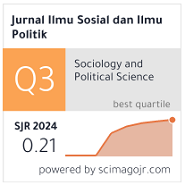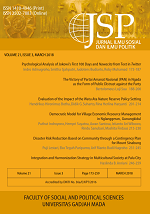Gerakan Buruh Pasca Soeharto: Politik Jalanan di Tengah Himpitan Pasar Kerja Fleksibel
https://doi.org/10.22146/jsp.10903
Muhtar Habibi
(1*)
(1) Peneliti Magister Administrasi Publik (MAP) Fisipol UGM
(*) Corresponding Author
Abstract
Labor movement after Soeharto shows different trend compare to the many view of the observers before. In the midst of the crush of neoliberal labor market flexibility, workers still often performs various street protests. The rising of minimum wage and changes in employment status towards more profitable one, are some workers material benefits gained through their street protest. Moreover, street protest also contributes to the making of collective workers identity. The high intensity of the street actions spawned the backlash from the capital and state. However, this attack rather than weaken the labor movement, instead it has the potential to encourage greater unity needs of the workers. The backlash from the capital and state during growing economic circumstances provide momentum to the emerging needs of modern interest organizations: a labor’ party. The future of the establishment labor’ party will depend on how much effort of the progressive elements in trade union able to leverage on the one hand a growing economy condition, and at the same time politically able to use reprisals of state and capital against their movement to create the need for the formation of an independent labor party for the rank and file workers.
Keywords
labor market flexibility; workers street-level politics; labor party; fleksibilitas pasar tenaga kerja; politik tingkat pekerja; partai buruh
DOI:
https://doi.org/10.22146/jsp.10903
Article Metrics
Abstract views : 5606
|
views : 13707
Refbacks
There are currently no refbacks.
Copyright (c) 2016 Jurnal Ilmu Sosial dan Ilmu Politik
<div class="statcounter"><a title="Web Analytics" href="http://statcounter.com/" target="_blank"><img class="statcounter" src="//c.statcounter.com/10932543/0/2e122c85/0/" alt="Web Analytics"></a></div> <div class="statcounter"><a title="Web Analytics Made Easy - StatCounter" href="http://statcounter.com/" target="_blank"><img class="statcounter" src="//c.statcounter.com/10932543/0/2e122c85/0/" alt="Web Analytics Made Easy - StatCounter"></a></div> View My Stats






















